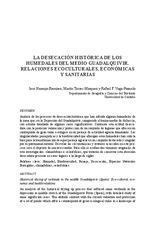Desecación histórica de los humedales del medio Guadalquivir. Relaciones ecoculturales, económicas y sanitarias
Historical drying of wetlands in the middle Guadalquivir (Spain). Eco-cultural, economic and health relations

Ver/
Autor
Naranjo-Ramírez, J.
Torres-Márquez, Martín
Vega-Pozuelo, Rafael
Editor
Universidad de AlicanteFecha
2016Materia
HumedalesBiodiversidad
Paisaje
Desecación
Espacios naturales protegidos
Lamafobia
Elosofobia
Wetlands
Biodiversity
Landscape
Natural protected areas
METS:
Mostrar el registro METSPREMIS:
Mostrar el registro PREMISMetadatos
Mostrar el registro completo del ítemResumen
Análisis de los procesos de desecación histórica que han sufrido algunos humedales de
la zona que, en la Depresión del Guadalquivir, comprende el tramo medio de dicho río,
con estudio detallado de algunos casos significativos. Contrasta esta actitud desecadora
con la posterior valoración y protección de un conjunto de lagunas que ofrecen un
contrapunto de gran valor ecológico en un paisaje de actividad agraria dominante. Las
singularidades paisajísticas y la biodiversidad que albergan estos humedales han sido la
base para la transformación de aquel paisaje agrario en un conjunto destacado y singular
por su patrimonio natural. Desvelar las circunstancias y avatares acaecidos en este proceso
será el objetivo de nuestro estudio. Para ello se acuñan dos términos originales de
esta investigación: «lamafobia» o «elosfobia», que tratarán de concretar esta obsesión
desecadora presente en estos lugares a lo largo de siglos An analysis of the historical drying up process that suffered some wetlands in the
depression in middle stretch of the Guadalquivir River (Spain), with detailed study of
some significant cases. This attitude contrast with the current valuation and protection
of a set of ponds which offer a counterpoint of great ecological value in a landscape of dominant agricultural activity. Landscape features and biodiversity that exist in these
wetlands have been the reason for the transformation of the agrarian landscape in a in a
prominent and singular set for its natural heritage. One of the objectives of our study is
to reveal the circumstances and vicissitudes that occurred in this process. To do this we
discovered two original terms of this research: «lamafobia» o «elosfobia», that realized
the obsession with the drying up of this places for centuries
